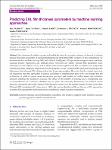Thông tin tài liệu
Thông tin siêu dữ liệu biểu ghi
| Trường DC | Giá trị | Ngôn ngữ |
|---|---|---|
| dc.contributor.author | Max, Marian | - |
| dc.contributor.author | Jonas, Mursak | - |
| dc.contributor.author | Marcel, Bartz | - |
| dc.date.accessioned | 2023-04-14T08:09:14Z | - |
| dc.date.available | 2023-04-14T08:09:14Z | - |
| dc.date.issued | 2022 | - |
| dc.identifier.uri | https://link.springer.com/article/10.1007/s40544-022-0641-6 | - |
| dc.identifier.uri | https://dlib.phenikaa-uni.edu.vn/handle/PNK/7953 | - |
| dc.description | CC BY | vi |
| dc.description.abstract | Non-dimensional similarity groups and analytically solvable proximity equations can be used to estimate integral fluid film parameters of elastohydrodynamically lubricated (EHL) contacts. In this contribution, we demonstrate that machine learning (ML) and artificial intelligence (AI) approaches (support vector machines, Gaussian process regressions, and artificial neural networks) can predict relevant film parameters more efficiently and with higher accuracy and flexibility compared to sophisticated EHL simulations and analytically solvable proximity equations, respectively. For this purpose, we use data from EHL simulations based upon the full-system finite element (FE) solution and a Latin hypercube sampling. | vi |
| dc.language.iso | en | vi |
| dc.publisher | Springer | vi |
| dc.subject | elastohydrodynamically lubricated | vi |
| dc.subject | finite element | vi |
| dc.title | Predicting EHL film thickness parameters by machine learning approaches | vi |
| dc.type | Book | vi |
| Bộ sưu tập | ||
| OER - Kỹ thuật điện; Điện tử - Viễn thông | ||
Danh sách tệp tin đính kèm:

